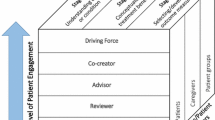Abstract
Over the last decade, there have been important changes in how patients participate in the research process. Historically, patients have been passive participants in the research process, with engagement at most meaning that a patient would respond to an advertisement to participate in a research study. As health and clinical trial information has become electronic and more easily distributed, patients are able to engage in research in different ways. This has affected all stages of the research process, from recruitment and consent, to participation and finally understanding the results of studies. These recent changes have helped overcome initial barriers to patient participation in trials. As research participation becomes even more driven by patient engagement, even more changes are expected with both potential benefits and risks to the research process.
Access this chapter
Tax calculation will be finalised at checkout
Purchases are for personal use only
Similar content being viewed by others
References
Prescott RJ, Counsell CE, Gillespie WJ, Grant AM, Russell IT, Kiauka S, et al. Factors that limit the quality, number and progress of randomised controlled trials. Health Technol Assess Winch Engl. 1999;3:1–143.
Drennan KB. Patient recruitment: the costly and growing bottleneck in drug development. Drug Discov Today. 2002;7:167–70.
Lovato LC, Hill K, Hertert S, Hunninghake DB, Probstfield JL. Recruitment for controlled clinical trials: literature summary and annotated bibliography. Control Clin Trials. 1997;18:328–52.
Peters-Lawrence MH, Bell MC, Hsu LL, Osunkwo I, Seaman P, Blackwood M, et al. Clinical trial implementation and recruitment: Lessons learned from the early closure of a randomized clinical trial. Contemp Clin Trials. 2012;33:291–7.
Patel CO, Garg V, Khan SA. What do patients search for when seeking clinical trial information online? AMIA Annu Symp Proc. 2010;2010:597–601.
Wilcox A, Natarajan K, Weng C. Using personal health records for automated clinical trials recruitment: the ePaIRing model. Summit Transl Bioinforma. 2009;2009:136–40.
Vayena E, Mastroianni A, Kahn J. Caught in the web: informed consent for online health research. Sci Transl Med. 2013;5:173fs6.
Do-It-Yourself Medicine | The Scientist Magazine® [Internet]. The Scientist. Available from: http://www.the-scientist.com/?articles.view/articleNo/34433/title/Do-It-Yourself-Medicine/. Cited 18 Mar 2014.
PatientsLikeMe Launches Campaign To Promote Health Data Sharing – iHealthBeat [Internet]. Available from: http://www.ihealthbeat.org/articles/2014/3/13/paitentslikeme-launches-campaign-to-promote-health-data-sharing. Cited 19 Mar 2014.
Cimino JJ. The false security of blind dates: chrononymization’s lack of impact on data privacy of laboratory data. Appl Clin Inform. 2012;3:392–403.
Malin B, Benitez K, Masys D. Never too old for anonymity: a statistical standard for demographic data sharing via the HIPAA privacy rule. J Am Med Inform Assoc. 2011;18:3–10.
Pulley J, Clayton E, Bernard GR, Roden DM, Masys DR. Principles of human subjects protections applied in an opt-out, de-identified biobank. Clin Transl Sci. 2010;3:42–8.
Weng C, Li Y, Berhe S, Boland MR, Gao J, Hruby GW, et al. An Integrated Model for Patient Care and Clinical Trials (IMPACT) to support clinical research visit scheduling workflow for future learning health systems. J Biomed Inform. 2013;46:642–52.
Yoon S, Elhadad N, Bakken S. A practical approach for content mining of Tweets. Am J Prev Med. 2013;45:122–9.
Bove R, Secor E, Healy BC, Musallam A, Vaughan T, Glanz BI, et al. Evaluation of an online platform for multiple sclerosis research: patient description, validation of severity scale, and exploration of BMI effects on disease course. PLoS ONE. 2013;8:e59707.
Know Thyself: Tracking Every Facet of Life, from Sleep to Mood to Pain, 24/7/365 [Internet]. WIRED. Available from: http://www.wired.com/medtech/health/magazine/17-07/lbnp_knowthyself?currentPage=all. Cited 19 Mar 2014.
Hood NE, Brewer T, Jackson R, Wewers ME. Survey of community engagement in NIH-funded research. Clin Transl Sci. 2010;3:19–22.
Israel BA, Schulz AJ, Parker EA, Becker AB. Review of community-based research: assessing partnership approaches to improve public health. Annu Rev Public Health. 1998;19:173–202.
Fagnan LJ, Davis M, Deyo RA, Werner JJ, Stange KC. Linking practice-based research networks and clinical and translational science awards: new opportunities for community engagement by academic health centers. Acad Med J Assoc Am Med Coll. 2010;85:476–83.
Bakken S, Suero-Tejada N, Bigger JT, Wilcox A, Boden-Albala B. Weaving a strong trust fabric through community-engaged research: lessons from the WICER project about digital infrastructure for the learning health system. 2014 Jt. Summits Transl Sci. San Francisco; 2014.
Additional Reading
Gary Wolf. Know thyself: tracking every facet of life, from sleep to mood to pain. 24/7/365. WIRED. http://www.wired.com/medtech/health/magazine/17-07/lbnp_knowthyself.
PatientsLikeMe. PatientsLikeMe research. http://news.patientslikeme.com/research.
Rachel Rettner. What is the quantified self? LiveScience. http://www.livescience.com/39185-quantified-self-movement.html.
Wilcox A, Natarajan K, Weng C. Using personal health records for automated clinical trials recruitment: the ePaIRing model. Summit Transl Bioinforma. 2009;2009:136–40.
Author information
Authors and Affiliations
Corresponding author
Editor information
Editors and Affiliations
Rights and permissions
Copyright information
© 2015 Springer-Verlag London
About this chapter
Cite this chapter
Wilcox, A.B. (2015). Patient Engagement and Consumerism. In: Payne, P., Embi, P. (eds) Translational Informatics. Health Informatics. Springer, London. https://doi.org/10.1007/978-1-4471-4646-9_9
Download citation
DOI: https://doi.org/10.1007/978-1-4471-4646-9_9
Published:
Publisher Name: Springer, London
Print ISBN: 978-1-4471-4645-2
Online ISBN: 978-1-4471-4646-9
eBook Packages: MedicineMedicine (R0)




